Why POMPANO?
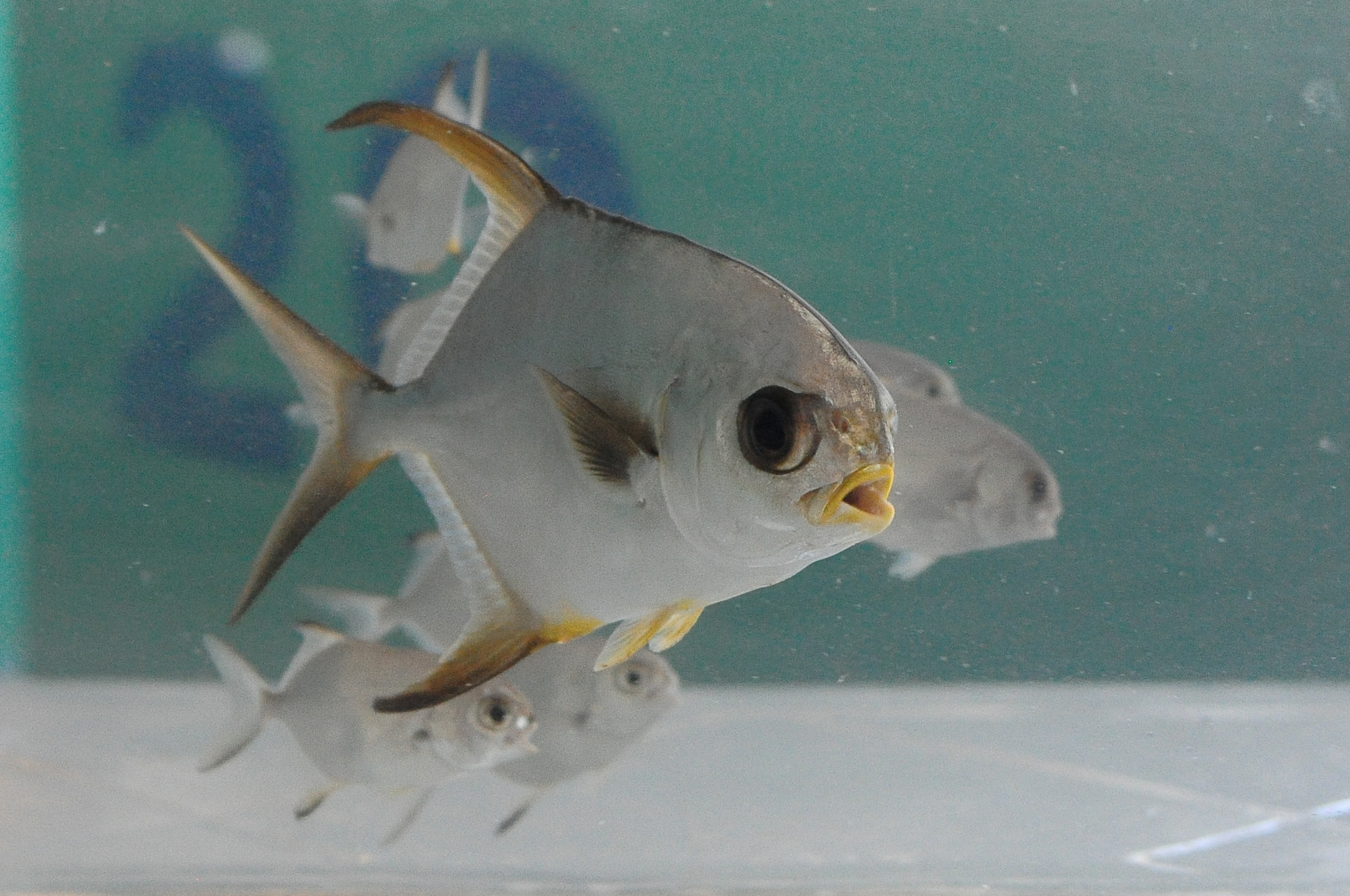 Pompano is a good candidate for aquaculture because it can easily adapt to captive conditions in ponds and cages. This species can also readily accept formulated feed (pellet) and can be grown at lower salinity (15–18 ppt). It is a pelagic fish that is easy to domesticate in marine and brackishwater environments.
Pompano is a good candidate for aquaculture because it can easily adapt to captive conditions in ponds and cages. This species can also readily accept formulated feed (pellet) and can be grown at lower salinity (15–18 ppt). It is a pelagic fish that is easy to domesticate in marine and brackishwater environments.
How to culture POMPANO?
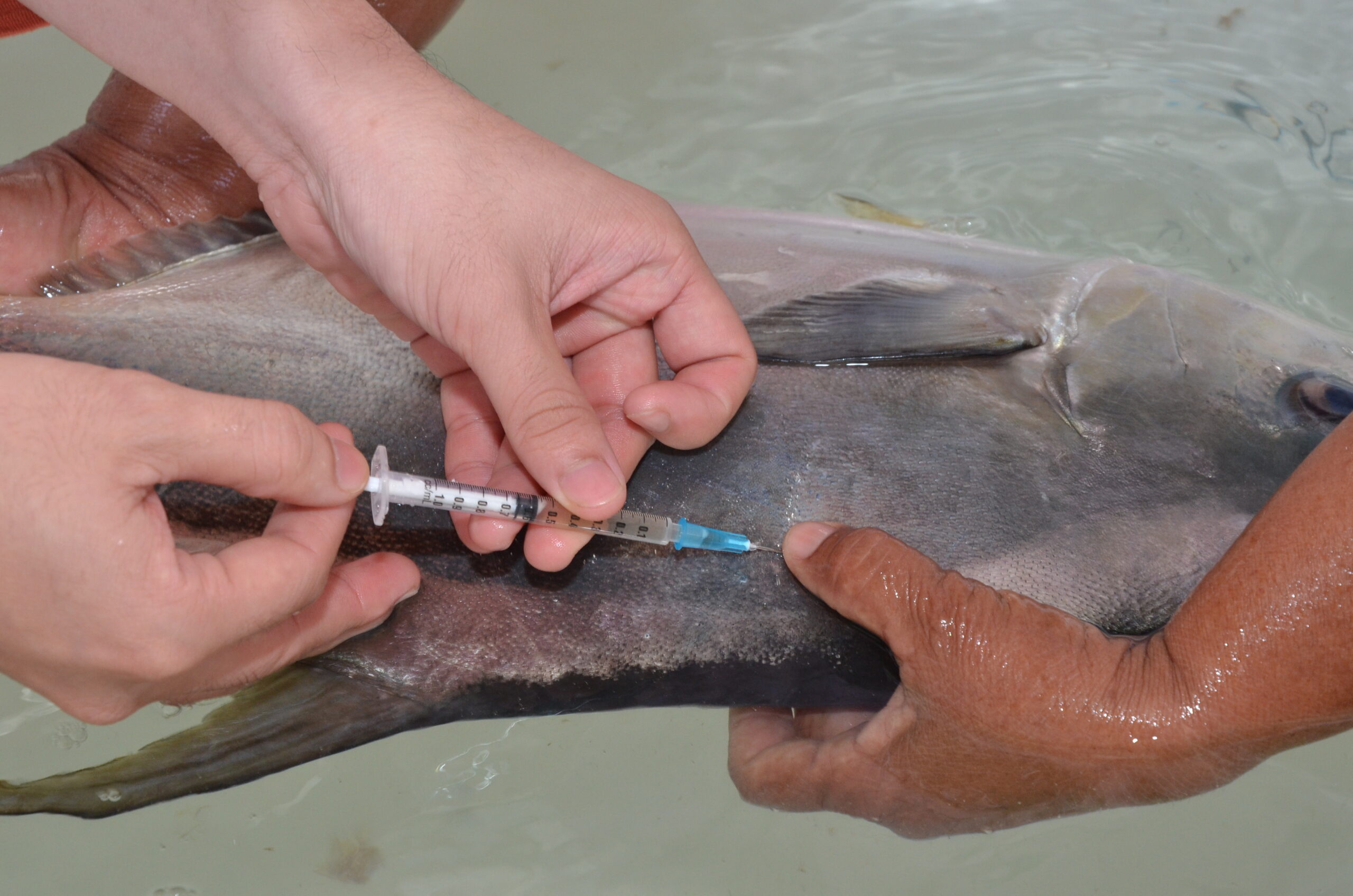
Spawning
- Select mature pompano. The recommended sex ratio is 1 female:2 male.
- Inject mature fish with the hormone human chorionic gonadotropin (HCG) at a dosage of 1,000 international units (IU) per kilogram of fish. Injection is done twice in two days: the first in the morning of the first day at 500 IU per kg of fish and the second dose on the next day at about the same time.
- After each injection, place the spawners in the spawning tank/cage that has a double net layer. Ovulation will take place 36–38 hours after the first injection. The eggs are released late at night or early in the morning (12:00 midnight to 4:00 a.m.). The size of the spawned egg is 0.8–0.85 mm.
Larval Rearing
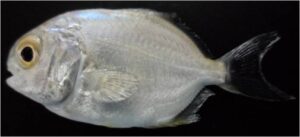
The ideal tank size for larval rearing of pompano is 5 tons for easy management.
- Prepare and fill half of the total tank volume with filtered seawater a day before the stocking.
- Stock newly-hatched larvae in the larval rearing tank (LRT) late in the afternoon at a density of 10 newly-hatched larvae per liter.
- Provide gentle aeration of 1-5 L per minute.
- Add the microalgae Nanochlorum to the LRT at 300,000 cells per milliliter starting Day 1. Rotifers, copepods, and Artemia sp. are the natural food that can be fed to the pompano larvae/fry.
- Practice co-feeding when changing sizes and type of food fed to the larvae/fry for 3–5 days.
- Wean to larval diet at Day 26 and natural food is gradually withdrawn for 5–7 days.
- Practice early morning (6–7 a.m.) and late afternoon (5–6 p.m.) feeding.
Nursery
Hatchery-produced fry need to undergo a nursery phase where they will be reared to become fingerlings fit for grow-out.
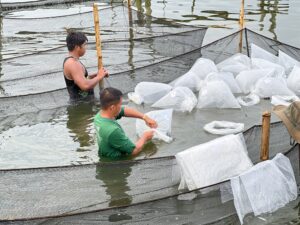
In brackishwater ponds
- Pond bottom soil should be clay loam or sandy clay loam.
- Stock 1.5-inch fry at a density of 150 fish per cubic meter in hapa nets (B-net, 5 m x 5 m x 1.5 m).
- Feed fish with formulated diets at 10 % of average body weight (ABW) per day, gradually decreasing to 8 % of ABW. Spread out feeding to four times per day. The amount of feed per day shall be given in equal rations.
- Lighting fixtures can be installed in the pond to concentrate small aquatic animals such as crustaceans and rotifers as supplemental food.
- Harvest pompano when they reach the weight of 30 g.
In marine cages
- Stock 1.5-inch fry at a density of 100 fish per cubic meter in 2 m x 2 m x 3 m nursery nets.
- Artificial illumination can be installed in the floating cages to attract several zooplanktons which will serve as supplemental food.
- Spread out feeding to four times per day. The amount of feed per day shall be given in equal rations.
- Harvest pompano when they reach the weight of 60 g.
Grow-out
In brackishwater ponds
- Stock 30-gram or bigger fingerlings to grow-out ponds at a stocking density of two fish per square meter.
- Spread out feeding to three times per day. The amount of feed per day shall be given in equal rations.
- Monitor water parameters such as dissolved oxygen, salinity, pH, temperature, and turbidity.
- Rear fish for about 175 days to attain the harvestable weight of about 360 gram.
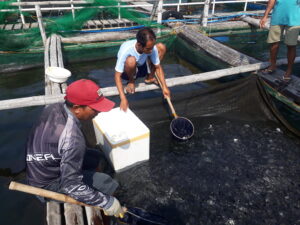
In marine cages
- Stock fingerlings to grow-out nets at a stocking density of 45 fish per cubic meter.
- Spread out feeding to three times per day. The amount of feed per day shall be given in equal rations.
- Monitor fish growth by weighing 5 % of the total stocks every 30 days.
- Monitor water parameters such as dissolved oxygen, salinity, pH, temperature, and turbidity.
- Rear fish until they attain a body weight of 350 g (about 130 days of culture).
Is POMPANO profitable?
Technical information in pompano pond operations
| Item | |
| Project duration (year) | 5 |
| Culture period (days, nursery to grow-out) | 210 |
| Total pond area for stocking (m2) | 10,000 |
| Stocking density (pcs/m2) | 2 |
| Number of fingerlings stocked per crop (pcs) | 20,000 |
| Number of pompano at harvest per crop (pcs) | 17,800 |
| Survival rate (%) | 89 |
| Average body weight, final (g) | 360 |
| Average body weight, initial (g) | 1 |
| Total weight gain (kg) | 6,390 |
| Total feed consumed (kg) | 12,432 |
| Feed conversion ratio | 1.94 |
| Volume of harvest per crop | 6,408 |
| Number of crops/year | 1 |
| Volume of harvest per year | 6,408 |
| Farm-gate price per kg body weight (PHP) | 350 |
Costs-and-returns (as of 2023)
| Total variable cost per year (PHP) | 1,262,107 |
| Total fixed cost per year (PHP) | 165,133 |
| Net income per year (PHP) | 815,561 |
| Internal rate of return (%) | 326.06 |
| Return-on-investment (%) | 300.17 |
| Return on feed cost (%) | 82.01 |
| Payback period (years) | 0.31 |
| Break-even price (PHP/kg) | 222.73 |
| Break-even volume of production (kg/crop) | 4,078 |
Technical information in pompano marine cage operations
| Item | |
| Project duration (year) | 5 |
| Culture period (days, nursery to grow-out) | 220 |
| Cage size (5 m x 5 m x 3 m) | 75 |
| Stocking density (pcs/m3) | 45 |
| Number of fingerlings stocked per unit (pc) | 3,375 |
| Number of pompano at harvest per crop per cage (pc) | 3,038 |
| Survival rate (%) | 90 |
| Average body weight, final (g) | 350 |
| Average body weight, initial (g) | 1 |
| Total weight gain (kg) | 1,061 |
| Total feed consumed (kg) | 2,428 |
| Feed conversion ratio | 2.29 |
| Volume of harvest per crop per cage (kg) | 1,063 |
| Number of cages | 4 |
| Volume of harvest from 4-cage operation per crop (kg) | 4,253 |
| Number of crops per year | 1 |
| Farm-gate price per kilogram (PHP) | 350 |
Costs-and-returns in a 1-cage operation (as of 2023)
| Total variable cost per year (PHP) | 277,130 |
| Total fixed cost per year (PHP) | 24,246 |
| Net income per year (PHP) | 70,718 |
| Internal rate of return (%) | 152 |
| Return-on-investment (%) | 139.1 |
| Payback period (years) | 0.66 |
| Break-even price (PHP/kg) | 283 |
| Break-even volume of production (kg/crop) | 861 |
References:
Baliao, D. D., Mamauag, R. E. P., de la Peña, L. D., Somblingo, E. H., Regatalio, K. D. L., & Dayrit, R. (2023). Nursery and grow-out culture of snubnose pompano (Trachinotus blochii, Lacepede) in brackishwater ponds. Tigbauan, Iloilo, Philippines: Aquaculture Department, Southeast Asian Fisheries Development Center.
Mamauag, R. E. P., Baliao, D. D., de la Peña, L. D., Tesorero, M. B., Yap, M. P. R., & Dayrit, R. (2023). Nursery and grow-out culture of snubnose pompano (Trachinotus blochii, Lacepede) in marine cages. Tigbauan, Iloilo, Philippines: Aquaculture Department, Southeast Asian Fisheries Development Center.
Reyes, O. S., de Jesus-Ayson, E. G. T., Pedroso, F. L., & Cabanilla, M. I. C. (2014). Hatchery production of snubnose pompano Trachinotus blochii Lacepede [Book]. Aquaculture Department, Southeast Asian Fisheries Development Center.
Madrones-Ladja, J., Opiña, N., Catacutan, M., Vallejo, E., & Cercado, V. (2012). Cage nursery of high-value fishes in brackishwater ponds: Seabass, grouper, snapper, pompano [Book]. Aquaculture Department, Southeast Asian Fisheries Development Center.
Need ASSISTANCE?
Get a copy of our publications!
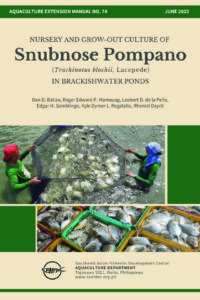 |
AEM 74 Nursery and grow-out culture of snubnose pompano (Trachinotus blochii, Lacepede) in brackishwater ponds DD Baliao et al (2023) 26 pp This manual tackles a viable technology that can guide fish farmers in raising pompano in brackishwater ponds. Each print copy costs US$5 Download here — File Size: 5.90 Mb |
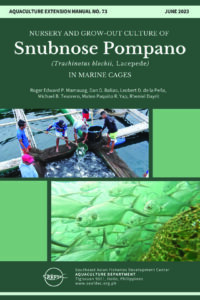 |
AEM 73 Nursery and grow-out culture of snubnose pompano (Trachinotus blochii, Lacepede) in marine cages REP Mamauag et al (2023) 34 pp This manual includes culture methods and good practices that are the product of research done at SEAFDEC/AQD. Each print copy costs US$6 Download here — File Size: 10.13 Mb |
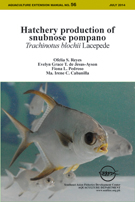 |
AEM 56 hatchery production of snubnose pompano Trachinotus blochii lacepede Ofelia Reyes et Al (2014) 26 pp A 26-page extension manual describing the biology, broodstock acquisition & management, larval rearing, harvest & transport and prevention of diseases & parasites in hatchery production of pompano. Each copy costs US$5 |
 |
AEM 54 Cage nursery of high-value fishes in brackishwater ponds ( sea bass, grouper, snapper, pompano) (2012) 24 pp Jocelyn Madrones-Ladja et al This extension manual describes nursery pond requirements, nursery rearing procedures, common diseases of young marine fish, and economic analysis of cage nursery as an enterprise separate from hatchery and grow-out culture. Each copy costs US$5 |
Check out our online bookstore for more titles: www.seafdec.org.ph/bookstore
Attend our hands-on training!
Marine Fish Hatchery and Cage/Pond Culture of Selected Marine Species training courses at AQD’s Tigbauan Main Station.
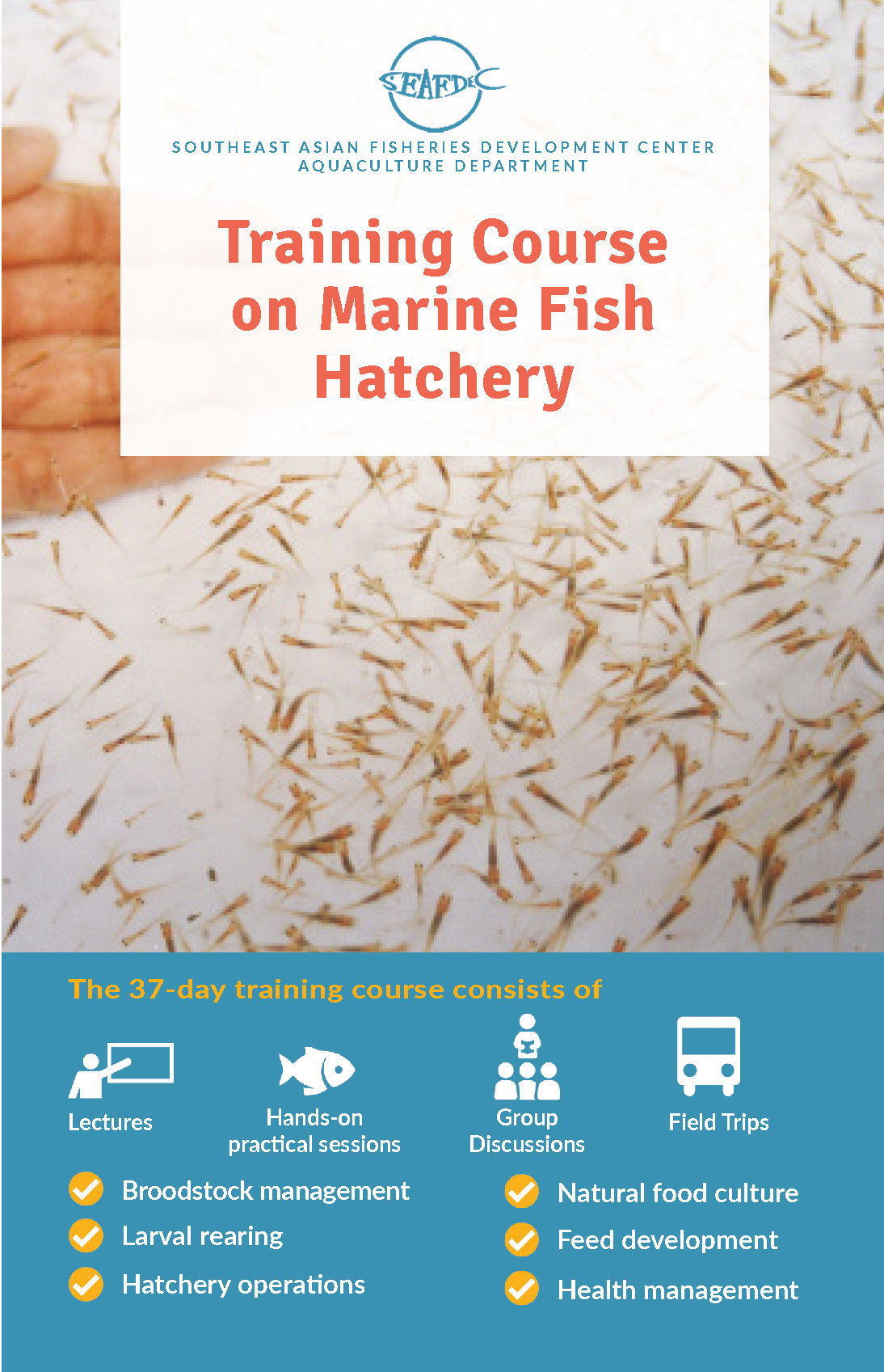 |
| View training brochure |
To apply, kindly contact:
Training and Information Division
(63-33) 330 7030
training@seafdec.org.ph
Check out our training schedule: www.seafdec.org.ph/training
 SEAFDEC/AQD Southeast Asian Fisheries Development Center | Aquaculture Department
SEAFDEC/AQD Southeast Asian Fisheries Development Center | Aquaculture Department